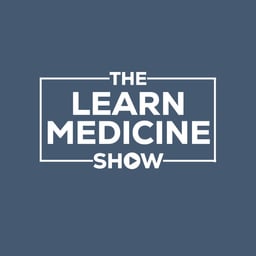
Heart murmurs for beginners Part 2: Atrial septal defect, ventricular septal defect & PDA
- March 4, 2025
- 9:00 am
Summary
This transcript discusses three distinct heart murmurs:
1. Atrial Septal Defect (ASD) - Characterized by an ejection systolic murmur with split S2. Symptoms may be asymptomatic or include dyspnea and growth issues. A left-to-right shunt can lead to complications like ischemic stroke.
2. Ventricular Septal Defect (VSD) - Presents as a pancystolic murmur, often asymptomatic but may include dyspnea. Associated with congenital issues and potential myocardial infarction.
3. Patent Ductus Arteriosus (PDA) - Produces a machinery murmur, symptoms include respiratory issues. Associated with prematurity and maternal infections. Follow-up includes monitoring for complications.
Topics:
[00:00 - 00:20] Introduction to Heart Murmurs
[00:20 - 01:00] Overview of Three Key Murmurs
[01:00 - 01:40] Understanding Heart Sounds and Turbulent Blood Flow
[01:40 - 03:20] Atrial Septal Defect (ASD) and Its Murmur
[03:20 - 05:20] Causes, Symptoms, and Risks of ASD
[05:20 - 07:20] Ventricular Septal Defect (VSD) and Its Murmur
[07:20 - 08:40] Causes, Symptoms, and Risks of VSD
[08:40 - 10:20] Patent Ductus Arteriosus (PDA) and Its Murmur
[10:20 - 11:20] Causes, Symptoms, and Risks of PDA
[11:20 - 12:00] Conclusion and Next Steps for Learning
Transcript
Introduction to Heart Murmurs
[00:00] Hello and welcome back to The Learn Medicine Show. My name is Dr Coleman and in this episode we are going to be reviewing three more heart murmurs. These murmurs include the ejection systolic murmur,
Overview of Three Key Murmurs
[00:20] with a split S2 found in atrial septal defect, the pancystolic murmur found in ventricular septal defect, and the machinery murmur found in the patent ductus arteriosus. By now you should be familiar with our diagram that depicts one movement through the cardiac cycle and that normal heart sounds sound like
[00:40] the phrase lub-dub. You should also be familiar with the concept that turbulent blood flow produces audible vibrations which can be visually represented with these sound wave patterns. If none of this sounds familiar, please go back and watch the previous video. I'll put a link at the top of the screen now. Okay so let's start by reviewing the murmur
Understanding Heart Sounds and Turbulent Blood Flow
[01:00] atrial septal defect. This presents with an ejection systolic murmur and splitting of the S2 heart's out. This murmur occurs during systole and is a crescendo decrescendo murmur. To help commit this murmur to memory you can use the phrase lub wash dubba. Okay so let's
[01:20] Let's add in the murmur now so you can appreciate how it sounds. Okay so let's take a moment now to
Atrial Septal Defect (ASD) and Its Murmur
[01:40] look at the atrial septum defect and how the murmur occurs. Here is our diagram of the heart. Let's remove the pulmonary artery and the aorta so that we can get a closer look at what's going on. So looking at this diagram you'll see that the left atrium and the right atrium are separated by a thin tissue called the interatrial septum and
[02:00] it's here where the atrial septal defects occur. Atrial septal defects effectively allow for an abnormal communication between the left and the right atria. With this information in mind, let's add in some blood flow and produce an animation to see what happens with this defect. It's during diastole where we see most of the action will
[02:20] the atrial septal defect and you can see here blood flowing from the atria into the vengefuls. But if we remove the aorta and the pulmonary artery we can get a closer look at what is happening. Blood pressure in the left side of the heart is naturally higher than that in the right side of the heart and this produces a pressure gradient that allows blood to
[02:40] flow from the left atrium into the right atrium. This is known as a left to right shunt. The key point to take away here is that the left to right shunt allows increased volume of blood to enter the right atrium and subsequently the right ventricle. So let's continue now by adding back in the aorta,
[03:00] and the pulmonary artery. As usual the S1 heart sound is produced by closure of the mitral and tricuspid valves and this produces the sound lumb. Systole then occurs and during this time the ventricles contract and force blood through the pulmonary and the aortic valves and is the
Causes, Symptoms, and Risks of ASD
[03:20] volume of blood in the right ventricle being forced through the pulmonary valve that produces turbulent blood flow resulting in our crescendo decrescendo systolic murmur. As systole comes to an end the aortic valve closes as normal producing the first half of the S2 heart cell.
[03:40] The second half of the SU heart sound is produced by delayed closure of the pulmonary valve and this delay occurs again because of the increased volume of blood flowing out of the right ventricle. So let's watch this process now in an animation with the murmur added in.
[04:00] Atrial septal defects effectively allow for abnormal workflow between the left and the right atrium. They are usually
[04:20] congenital and caused by failed closure of the foramen ovale. You may be asking yourself what on earth is the foramen ovale? Well the foramen ovale is an adaptation of fetal circulation that allows blood to bypass the lungs and it usually closes shortly after birth. Atrial
[04:40] Multiple effects or defects are more common in females and also have increased frequency with maternal alcohol use during pregnancy. In the clinical history, the presentation may be asymptomatic. However, those that are symptomatic may have dyspnea and faltering growth. In later life, other symptoms may occur.
[05:00] The left to right shunt can reverse due to increased pulmonary pressures and this produces a syndrome called isomegas. Atrial septal edific may also present as a ischemic stroke in later life. Here small blood clots form in the venous system and these are able to pass for
Ventricular Septal Defect (VSD) and Its Murmur
[05:20] the right to the left side of the heart through the defect. Once in the arterial circulation, they can go onto the brain to cause strokes. So any young person that has an unexplained stroke should go on to have a check for atrioseptal defect. The murmur produced in atrioseptal defect is an ejection
[05:40] systolic murmur with splitting of the S2. It is heard loudest in the left upper sternal border and radiates through to the back of the thorax. And now let's turn our attention to ventricular septal defects. This presents as a pan-systolic murmur, which essentially means that it occurs throughout the
[06:00] entire duration of systole. This murmur can be visually represented with a plateau wave. To commit this murmur to memory, think about a burry noise that occurs throughout the duration of systole. Let's listen to this now.
[06:20] Let's take a moment to look at the anatomy of the ventricular septal defect. The left and right ventricle are separated by a thin membrane of tissue known as the interventricular septum. It is here where ventricular
[06:40] tricuspid and mitral valves close. However, due to increased
[07:00] pressure in the left ventricle compared to the right ventricle, a left to right shunt occurs across the ventricular septal defect. This produces turbulent blood flow which generates our pancystolic Burma. The aortic and pulmonary valves close and the cycle begins all over.
Causes, Symptoms, and Risks of VSD
[07:20] again. It's worth noting that the S1 and S2 heart sounds are difficult to hear in the context of a pancystolic murmur, often because the murmur itself is so land that it drowns them out. Let's watch the animation now and listen to the murmur.
[07:40] Let's pause for a moment to learn more about ventricular septal defects. They effectively form an abnormal communication between the left and right ventricles. Ventricular septal defects are a common type of congenital heart disease.
[08:00] It occurs due to abnormal development of the ventricular septum early in fetal development. Genetics also contribute to the development of ventricular septal defects. The risk is increased in those with a strong family history and also in conditions such as Trisomy 21, otherwise known as Down's Syndrome. With the
[08:20] In the case of the chemicarp disease, particularly with myocardial infarction, reduced blood supply to the ventricular septum can cause it to break down and rupture, producing a ventricular septal defect. The clinical history may be asymptomatic, but may include dyspnea and failure to thrive.
Patent Ductus Arteriosus (PDA) and Its Murmur
[08:40] is a pancystolic murmur that is loudest at the left sternal edge. Our final murmur in the series is that of patent doctor's arterioses. This is described as a machinery murmur and it occurs throughout systole and diastole. The murmur is represented visually
[09:00] with a plateau wave that runs throughout systole and diastole. To help commit this one to memory, think about a continuous burring sound that runs the whole length of the cardiac cycle. We'll add in the murmur now so you can appreciate this.
[09:20] The ductus arteriosus is a fetal vascular structure that allows blood to bypass the lungs during fetal development. It usually closes 48 hours after birth, but if it remains patent then it
[09:40] allows an abnormal communication between the aorta and the pulmonary artery. The murmur is produced due to the high aortic blood pressures and lower pulmonary pressures, creating a gradient that allows for a left to right shunt, where blood continuously flows from the aorta into the pulmonary artery.
[10:00] A continuous stream of turbulent blood flow produces the machinery murmur both through systole and diastole. Whilst the murmur is being produced, the mitral and tricuspid valves close. The S1 heart sound is not heard because the murmur is too loud and drowns it out. Systole then occurs with blood being
Causes, Symptoms, and Risks of PDA
[10:20] pumped into the pulmonary artery and the aorta and at the end of systole the pulmonary and the aortic valves close. The S2 heart sound is not heard again because the murmur is too loud and drowns it out. The murmur continues to rumble throughout diastole. So let's add in the animation now and listen to the murmur as it occurs.
[10:40] So the patent ductus arteriosus is the persistence of a fetal vascular structure after birth. There is increased risk of
[11:00] developing this condition with premature birth, with maternal rubella infection during pregnancy, and with female gender. The history may present with shortness of breath, recurrent respiratory infections, or failure to thrive. Patient ductus arteriosus produces a machinery murmur which is a low-pitch
Conclusion and Next Steps for Learning
[11:20] rumblin murmur that is continuous throughout systole and diastole. It is loudest in the left infraclavicular area. Other signs you may see on clinical examination is a systolic thrill, bounding peripheral pulse and a widened pulse pressure. And that brings us to the end of our Heart Murs' module. Please take
[11:40] look at the self-test that I'm posting where you can test your ability to identify murmurs by answering some simple questions. Also don't forget to head over to the YouTube community channel where you'll be able to vote on the topic for the next Learn Medicine show. Really value your input because I want to be making videos that are useful for you. And with that said,
[12:00] Don't forget to like and subscribe and share with your friends. Thanks for stopping by, I'll see you in the next show.
